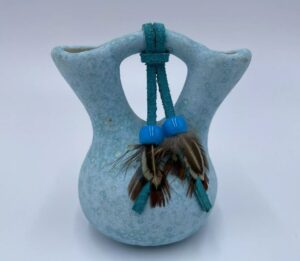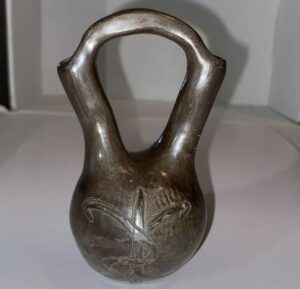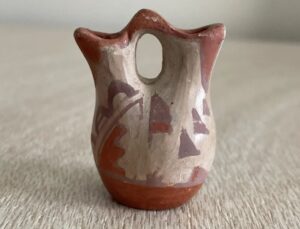Do you remember the awe and reverence in the air at community gatherings when the elders would bring out traditional artifacts, each carrying a story of the tribe’s heritage and values? One such artifact, the Native American wedding vase, often took a place of honor at these events. If you’ve ever attended a wedding where this vase was used, you might recall the quiet moments of unity it inspired as the couple performed the drinking ceremony, an emblem of their commitment and love.
The creation of a wedding vase is a spiritual process, usually undertaken by a skilled artisan of the tribe. The crafting begins with the gathering of clay, which is often sourced from sacred lands known to the community. The clay is cleaned, treated, and then shaped by hand or with the use of simple tools. The two-spouted design is not just functional; it is a representation of the life paths of the individual bride and groom, which, though they start as separate, will merge into one through marriage.

The design elements and decorations added to the vase are rich with cultural symbolism. These might include depictions of nature, such as the earth, sky, or water, which are significant in many Native American cultures for their life-giving properties. Other common symbols might include animals, which represent various virtues or tribal totems. The decorations are not only artistic expressions but also imbue the vase with blessings and prayers for the couple’s future.
During the wedding ceremony, the vase plays a central role. It is filled with a sacred liquid, which could be plain water, symbolizing purity and life, or an herbal brew, which might include ingredients significant to the tribe for their health-giving properties. The couple each drink from their respective spouts at the same time, a challenging act that symbolizes the couple’s future shared experiences. Successfully drinking at the same time without spilling is considered a good omen for the marriage, signifying that the couple will work well together in facing life’s challenges.

This ritual is not just about the act of drinking but is a profound demonstration of balance and support, foundational qualities in any marriage. The ceremony and the vase itself teach the couple—and remind the community—about the importance of cooperation and mutual support. Today, while modern influences continue to blend with traditional practices, the use of the wedding vase in ceremonies remains a powerful link to the past, often serving as a poignant reminder of a couple’s roots and cultural identity.
Once the ceremony is over, the vase holds continued significance. It is often kept as a cherished keepsake, displayed in the couple’s home as a reminder of their vows and the support of their community. In some traditions, the vase is passed down to the next generation as a family heirloom, carrying with it the stories and blessings of ancestors.

This tradition is a beautiful example of how physical objects are imbued with cultural meanings and how they function within ceremonial life to reinforce social bonds, not only between individuals but also across generations within the community.
#Lifestyle #Stories #Vintage





